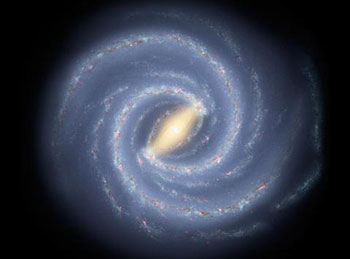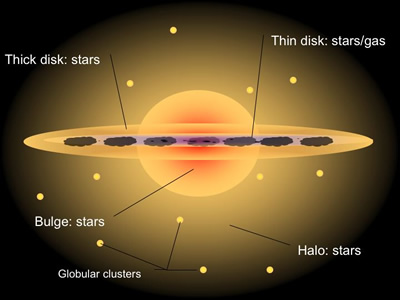Astronomers have found two just-born star clusters, part of our galaxy's stellar disk, that float an incredible 16,000 light-years above the plane of the Milky Way.

NASA / JPL-Caltech
Two clusters of stars, still embedded in their natal clouds of dust and gas, are floating 16,000 light-years above the pancake-shaped disk of the Milky Way.
Denilso Camargo (Colegio Militar de Porto Alegre, Brazil) and colleagues reported the surprising find, part of a larger study of embedded star clusters in Wide-field Infrared Survey Explorer (WISE) data, in the February 26th Monthly Notices of the Royal Astronomical Society.
The Milky Way is a paper-thin spiral galaxy, with 85% of its stars in a disk about 100,000 light-years across and only 3,000 light-years tall. A thicker and sparser disk of older stars extends up to 16,000 light-years above the galactic plane. The two disks appear to contain distinct stellar populations — the thick disk likely forged stars at an earlier stage of the Milky Way’s formation.

Swinburne University
So the discovery of new stars so far above the galactic plane, firmly in thick disk territory, is unexpected to say the least. No other such high-altitude star clusters have ever been found, even though violent supernova explosions have ejected plenty of molecular hydrogen clouds high above the galaxy’s plane, any of which could potentially form stars given the right trigger.
The star clusters themselves are only about 2 million years old. Their age, distance, and mass come from models that Camargo’s team fit to the color and brightness measurements of their stellar populations.
At an altitude of 16,000 light-years, the 33 and 42 stars belonging to clusters Camargo 438 and Camargo 439, respectively, have an exceptional (if heavily obscured) outsider’s view of the Milky Way’s spiral design. But they won’t for long, astronomically speaking. The authors calculated the velocity of the cloud containing the young and still-forming stars, and they find that the cloud has crossed paths with the disk before, sometime between 45 and 50 million years ago, an event that likely caused the clouds to condense and form stars. The clusters will cross paths with the disk again in another 50 million years or so.
To read more, see the Royal Astronomical Society’s press release.
 0
0
Comments
You must be logged in to post a comment.